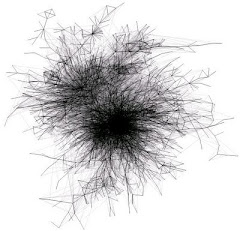“Are there laws which determine the number, size, and distribution of towns?”
W. CHRISTALLER
MAKSE et al. Developped in the 90s a mathematical model (Correlated Percolation Model) that relates the pysical form of a city and the system within which it exits. This was based on the ideas of percolation theory and they took into account two key points.
First, data on population density of actual urban systems are known to conform to the relation ρ(r)= ρ0e-λr where r is the radial distance from the urban core, and λ is the density gradient.
Second, in actual urban systems, the development units are not positioned at random. Rather, there exist correlations arisin from the fact that when a development unit is located in a given place, the probability of adjacent development units increases. The next figure shows a qualitatie comparison between the actual urban data and the proposed model.
In addition to the strongly correlation between the morphology of actual urban areas and the urban systems obtained in our simulation, the dynamics of the model shows a remarkable pattern of decentralization, a phenomena that occurs in most of the cities in the world.
The use of fractal or chaotic models leads us to view cities as self-organized systems by local actions instead of designs for a centralized intelligence. This fact could give us a wide variety of valuable information concerning the way cities grow and change, and more importantly, the way they might be planned and managed.








